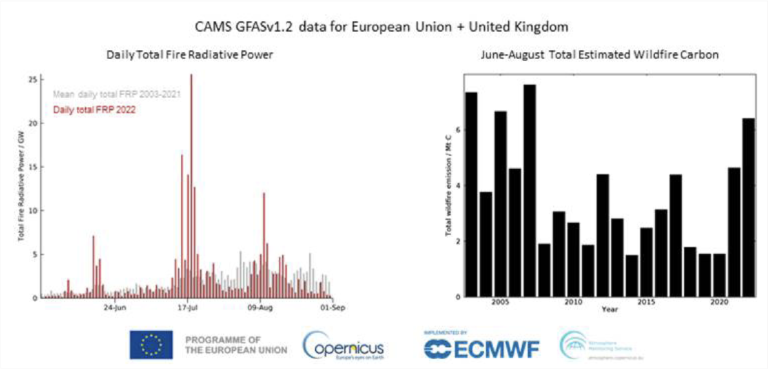The Copernicus Atmosphere Monitoring Service (CAMS) has reported that this year’s wildfires across Europe caused the highest emissions since 2007.
The combination of August’s heatwave with prolonged dry conditions across Western Europe resulted in increased wildfire activity, intensity and persistence.
According to data from the CAMS Global Fire Assimilation System (GFAS), which uses satellite observations of wildfire locations and fire radiative power (FRP) – a measure of intensity to estimate emissions of the air pollutants that are present in the smoke – the total wildfire emissions from the European Union plus the UK from June 1 to August 31, 2022, are estimated to be 6.4 megatons of carbon.
CAMS, implemented by the European Centre for Medium-Range Weather Forecasts (ECMWF), reports that the emissions recorded for summer 2022 were largely driven by wildfires across Southwestern France and the Iberian Peninsula, with France and Spain experiencing their highest wildfire emissions in the last 20 years.
In other regions around the northern hemisphere, which typically experience a peak in wildfire activity during the summer months, the total estimated emissions were considerably less than in recent years. The Sakha Republic and Chukotka Autonomous Oblast in the far east of Russia did not experience as much fire as recent summers, with most fires this summer further south in Khabarovsk Krai. More central and westerly regions of Russia, including Khanty-Mansy Autonomous Okrug and Ryazan Oblast, experienced higher numbers of wildfires resulting in several days of thick smoke and degraded air quality. Total estimated emissions from the fires in the Central Federal District of Russia were the highest since the large peat fires which affected West Russia in 2010.
In North America, wildfires that started burning in Alaska in May continued through June and early July with large fires in the Yukon and Northwest Territories of Canada. In the Western United States daily total fire intensity and seasonal total emissions were much lower for California, Oregon, Washington, Idaho and Montana in comparison to the summers of 2020 and 2021 and were more typical for the time of year, according to the CAMS GFAS data.
Mark Parrington, senior scientist and wildfire expert, CAMS, said, “The scale and persistence of the fires in the Southwest of Europe leading to the highest emissions for Europe in 15 years was extremely concerning throughout the summer. The majority of the fires occurred in places where the changing climate has increased the flammability of the vegetation such as in Southwestern Europe, and as we have seen in other regions in other years. CAMS is now closely monitoring the current fire emissions and smoke transport in the Amazon region, and across South America, as the peak fire season approaches in the coming weeks.”



